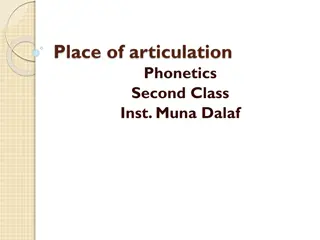Understanding Articulatory Aspects of English Speech Sounds
Speech sounds are integral to language, with articulatory, acoustic, auditory, and functional aspects. Articulation involves mechanisms like the power, vibrator, resonator, and obstruction mechanisms. The power mechanism includes the respiratory system, while the vibrator mechanism operates through the vocal cords in the larynx. Exploring these aspects helps in understanding how speech sounds are produced and perceived.
Download Presentation

Please find below an Image/Link to download the presentation.
The content on the website is provided AS IS for your information and personal use only. It may not be sold, licensed, or shared on other websites without obtaining consent from the author. Download presentation by click this link. If you encounter any issues during the download, it is possible that the publisher has removed the file from their server.
E N D
Presentation Transcript
The articulatory aspects of English speech sounds Plan: 1. ASPECTS OF SPEECH SOUNDS. 2. ARTICULATORY ASPECT. 3. FOUR MECHANISMS OF ARTICULATION
Aspects of speech sounds Speech sounds are the material form in which language exists. It is the most genetic definition of speech sounds, which are produced by a man s speech apparatus and which are perceived by its hearing apparatus. In the language sounds function as phonemes. That s why we can speak about 4 aspects of speech sounds (articulatory, acoustic, auditory, functional). To analyze a speech sound physiologically and articulatory some data on the articulatory mechanism and its work should be introduced.
The aspects of speech sounds 1. The articulatory aspect: a) four mechanisms of articulation; b) articulatory basis. 2. The acoustic and auditory aspects. 3. The functional (social or phonological) aspect.
Articulatory aspect Articulation comprises all the movements and positions of the speech organs necessary to pronounce a speech sound. Speaking about articulation we mean positions and movements of the speech apparatus. According to their main sound-producing functions, the organs of speech can be divided into 4 mechanisms of articulation according to their work:
4 mechanisms of articulation 1) the power mechanism; 2) the vibrator mechanism; 3) the resonator mechanism; 4) the obstruction mechanism.
The power mechanism The power mechanism consists of the diaphragm, the lungs, the bronchi, the windpipe or trachea, the glottis (the opening between the vocal folds), the pharynx, the mouth and nasal cavities. The source of energy for our vocal activity is provided by an air-stream expelled from the lungs. This air- stream undergoes important modifications before it acquires the quality of a speech sound. First of all in the trachea it passes through the larynx, containing the so-called vocal cords.
The vibrator mechanism The vibrator mechanism (the voice production mechanism) consists of the vocal folds. They are in the larynx or voice box. The vocal cords are 2 horizontal folds of elastic tissue. They may be opened or closed (completely or incompletely). The pitch of the voice is controlled mostly by the tension of the vocal cords. Voice produced by the vocal cords vibration is modified by the shape and volume of the air passage.
The vocal folds The vocal folds are responsible for voice producing. When the vocal folds are brought together and vibrate, voiced consonants are produced. When the vocal folds are set apart and do not vibrate, voiceless consonants are produced. The number of vibrations in the case of a man s voice is 100 150 times a second, a woman s 200 325 per second. The vocal folds may vibrate all over and then we speak about the fundamental frequency of vibration; when they vibrate in parts, a number of overtones or harmonics are produced.
The resonator mechanism The resonator mechanism consists of the supra-glottal cavities of the pharynx, larynx, the mouth and nasal cavities. All these organs of speech are responsible for different voice timbres (Timbre I and Timbre II emotional coloring of a human voice). By changing the position of the walls of the cavities different voice timbres are produced.
The obstruction mechanism The obstruction mechanism is responsible for the production of consonants only; because there is an articulatory obstruction to the air stream (this obstruction can be complete, incomplete or intermediate). It consists of the teeth, the lips, the tongue, the soft palate with the uvula, the hard palate and the alveolar ridge. It should be borne in mind that the four mechanisms work simultaneously and that each speech sound is the result of the simultaneous work of all of them.























